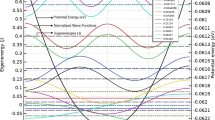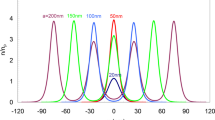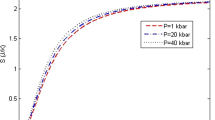Abstract
In this paper, a GaAs quantum wire is considered with a semi-parabolic lateral confinement potential in the presence of a crossed electromagnetic field with the inclusion of Rashba SOI. The effects of pressure on thermodynamic properties have been studied. To this end, first, the eigenenergies for the system have been calculated considering Rashba spin effects under electric and magnetic fields. Then a numerical analysis is done to derive the partition function and obtain the system's thermodynamic properties. The results show that at low temperatures, all four thermodynamic properties don’t show much effect due to pressure. It is found that entropy increases with increasing hydrostatic pressure, whereas pressure affects mean energy and free energy in a different manner. A peak structure is observed in specific heat as a function of temperature where the peak position depends on hydrostatic pressure.











Similar content being viewed by others
References
C.M. Lieber, One-dimensional nanostructures: chemistry, physics & applications. Solid State Commun. 107, 607–616 (1998). https://doi.org/10.1016/s0038-1098(98)00209-9
G.A. Prinz, Magnetoelectronics. Science 282, 1660–1663 (1998). https://doi.org/10.1126/science.282.5394.1660
Y. Xia, P. Yang, Y. Sun, Y. Wu, B. Mayers, B. Gates, Y. Yin, F. Kim, H. Yan, One-dimensional nanostructures: synthesis, characterization, and applications. Adv. Mater. 15, 353–389 (2003). https://doi.org/10.1002/adma.200390087
A. Martinez-Gil, A. Rota, T. Maroutian, B. Bartenlian, P. Beauvillain, E. Moyen, M. Hanbücken, Nano-patterned silicon surfaces for the self-organised growth of metallic nanostructures. Superlattices Microstruct. 36, 235–243 (2004). https://doi.org/10.1016/j.spmi.2004.08.006
A.L. Fernandes Cauduro, L.H. Hess, D.F. Ogletree, J.W. Schwede, A.K. Schmid, Tailoring low energy electron absorption via surface nano-engineering of cesiated chromium films. Appl. Phys. Lett. 115, 071602 (2019). https://doi.org/10.1063/1.5099115
S. Axelsson, Ee.B. Campbell, L.M. Jonsson, J. Kinaret, S.W. Lee, Y.W. Park, M. Sveningsson, Theoretical and experimental investigations of three-terminal carbon nanotube relays. New J. Phys. 7, 245–245 (2005). https://doi.org/10.1088/1367-2630/7/1/245
C. Somaschini, S. Bietti, N. Koguchi, S. Sanguinetti, Coupled quantum dot–ring structures by droplet epitaxy. Nanotechnology 22, 185602 (2011). https://doi.org/10.1088/0957-4484/22/18/185602
M. Law, D.J. Sirbuly, J.C. Johnson, J. Goldberger, R.J. Saykally, P. Yang, Nanoribbon waveguides for subwavelength photonics integration. Science 305, 1269–1273 (2004). https://doi.org/10.1126/science.1100999
J.D. Sau, S. Tewari, S. Das Sarma, Universal quantum computation in a semiconductor quantum wire network. Phys. Rev. A (2010). https://doi.org/10.1103/physreva.82.052322
M. Sundaram, S.A. Chalmers, P.F. Hopkins, A.C. Gossard, New quantum structures. Science 254, 1326–1335 (1991). https://doi.org/10.1126/science.254.5036.1326
J. Adamowski, A. Kwaśniowski, B. Szafran, LO-phonon-induced screening of electron–electron interaction in D-centres and quantum dots. J. Phys.: Condens. Matter 17, 4489–4500 (2005). https://doi.org/10.1088/0953-8984/17/28/008
M. Ciurla, J. Adamowski, B. Szafran, S. Bednarek, Modelling of confinement potentials in quantum dots. Physica E 15, 261–268 (2002). https://doi.org/10.1016/s1386-9477(02)00572-6
W. Xie, Investigation of D-centers confined by spherical quantum dots. Physica Status Solidi (b). 245, 101–105 (2008). https://doi.org/10.1002/pssb.200743116
D.C. Banerjee, Review synthesis of conducting nanowires. J. Mater. Sci. 37, 4261–4271 (2002). https://doi.org/10.1023/A:1020663731437
E.I. Rashba, Properties of semiconductors with an extremum loop. I. Cyclotron and combinational resonance in a magnetic field perpendicular to the plane of the loop. Soviet Phys. Solid State. 2, 1109 (1960)
G. Dresselhaus, Spin-orbit coupling effects in zinc blende structures. Phys. Rev. 100, 580–586 (1955). https://doi.org/10.1103/physrev.100.580
G. Engels, J. Lange, Th. Schäpers, H. Lüth, Experimental and theoretical approach to spin splitting in modulation-dopedInxGa1−xAs/InP quantum wells for B→0. Phys. Rev. B 55, R1958–R1961 (1997). https://doi.org/10.1103/physrevb.55.r1958
T. Koga, J. Nitta, T. Akazaki, H. Takayanagi, Rashba spin-orbit coupling probed by the weak antilocalization analysis inInAlAs/InGaAs/InAlAs quantum wells as a function of quantum well asymmetry. Phys. Rev. Lett. (2002). https://doi.org/10.1103/physrevlett.89.046801
Priyanka, R. Sharma, M. Kumar, Effect of hydrostatic pressure and temperature on the ballistic conductance under the influence of Rashba spin-orbit coupling, Physica B: Condensed Matter. 648 (2023) 414402. https://doi.org/10.1016/j.physb.2022.414402.
A.J. Read, R.J. Needs, K.J. Nash, L.T. Canham, P.D.J. Calcott, A. Qteish, First-principles calculations of the electronic properties of silicon quantum wires. Phys. Rev. Lett. 69, 1232–1235 (1992). https://doi.org/10.1103/physrevlett.69.1232
R. Khordad, Simultaneous effects of electron–electron interactions, Rashba spin-orbit interaction and magnetic field on susceptibility of quantum dots. J. Magn. Magn. Mater. 449, 510–514 (2018). https://doi.org/10.1016/j.jmmm.2017.10.085
S.A. Tarasenko, N.S. Averkiev, Interference of spin splittings in magneto-oscillation phenomena in two-dimensional systems. J. Exp. Theor. Phys. Lett. 75, 552–555 (2002). https://doi.org/10.1134/1.1500719
S. Dahiya, S. Lahon, R. Sharma, Effects of temperature and hydrostatic pressure on the optical rectification associated with the excitonic system in a semi-parabolic quantum dot. Physica E: Low-Dimens. Syst. Nanostruct. 118, 113918 (2020). https://doi.org/10.1016/j.physe.2019.113918
R. Khordad, Optical properties of quantum wires: Rashba effect and external magnetic field. J. Lumin. 134, 201–207 (2013). https://doi.org/10.1016/j.jlumin.2012.08.047
M. Kumar, S. Lahon, P.K. Jha, M. Mohan, Energy dispersion and electron g-factor of quantum wire in external electric and magnetic fields with Rashba spin orbit interaction. Superlattices Microstruct. 57, 11–18 (2013). https://doi.org/10.1016/j.spmi.2013.01.007
R. Khordad, H.R. Rastegar Sedehi, Low temperature behavior of thermodynamic properties of 1D quantum wire under the Rashba spin-orbit interaction and magnetic field. Solid State Commun. 269, 118–124 (2018). https://doi.org/10.1016/j.ssc.2017.10.018
Y. Karaaslan, B. Gisi, S. Sakiroglu, E. Kasapoglu, H. Sari, I. Sokmen, Rashba spin-orbit coupling effects on the optical properties of double quantum wire under magnetic field. Superlattices Microstruct. 93, 32–39 (2016). https://doi.org/10.1016/j.spmi.2016.02.043
D. Najafi, B. Vaseghi, G. Rezaei, R. Khordad, Thermodynamics of mono-layer quantum wires with spin-orbit interaction. Eur. Phys. J. Plus (2018). https://doi.org/10.1140/epjp/i2018-12102-3
R. Khordad, H.R.R. Sedehi, Thermodynamic properties of a double ring-shaped quantum dot at low and high temperatures. J. Low Temp. Phys. 190, 200–212 (2017). https://doi.org/10.1007/s10909-017-1831-x
R. Khordad, Ar. Firoozi, H.R.R. Sedehi, Simultaneous effects of temperature and pressure on the entropy and the specific heat of a three-dimensional quantum wire: tsallis formalism. J. Low Temp. Phys. 202, 185–195 (2020). https://doi.org/10.1007/s10909-020-02536-w
P. Başer, I. Altuntas, S. Elagoz, The hydrostatic pressure and temperature effects on hydrogenic impurity binding energies in GaAs/InxGa1-xAs/GaAs square quantum well. Superlattices Microstruct. 92, 210–216 (2016). https://doi.org/10.1016/j.spmi.2015.12.010
P. Baser, H.D. Karki, I. Demir, S. Elagoz, The hydrostatic pressure and temperature effects on the binding energy of magnetoexcitons in cylindrical quantum well wires. Superlattices Microstruct. 63, 100–109 (2013). https://doi.org/10.1016/j.spmi.2013.08.021
S. Debald, B. Kramer, Rashba effect and magnetic field in semiconductor quantum wires. Phys. Rev. B (2005). https://doi.org/10.1103/physrevb.71.115322
A.M. Babayev, Ö. Mercan, S. Tez, Electron Lande g-factor in GaAs/Al Ga1−As quantum wires. Physica E 41, 345–348 (2009). https://doi.org/10.1016/j.physe.2008.06.030
Author information
Authors and Affiliations
Contributions
PK, SA, and YG contributed to Methodology, Software, Validation, Formal analysis, Data Curation, Writing—Original Draft, Conceptualization, Formal analysis, Writing—Review & Editing, and Visualization. Priyanka and RS contributed to Resources, Investigation, Supervision, Writing—Review & Editing, and Project administration.
Corresponding author
Ethics declarations
Competing interest
The authors declare no competing interests.
Additional information
Publisher's Note
Springer Nature remains neutral with regard to jurisdictional claims in published maps and institutional affiliations.
Rights and permissions
Springer Nature or its licensor (e.g. a society or other partner) holds exclusive rights to this article under a publishing agreement with the author(s) or other rightsholder(s); author self-archiving of the accepted manuscript version of this article is solely governed by the terms of such publishing agreement and applicable law.
About this article
Cite this article
Khosla, P., Arora, S., Gupta, Y. et al. Hydrostatic Pressure Effect on the Thermodynamic Properties of Quantum Wire Under a Crossed Electromagnetic Field. J Low Temp Phys 213, 92–106 (2023). https://doi.org/10.1007/s10909-023-02990-2
Received:
Accepted:
Published:
Issue Date:
DOI: https://doi.org/10.1007/s10909-023-02990-2




